The COVID-19 pandemic prompted a surge in telework, with dramatic increases in the number of employees working from home (teleworking) in many European countries. What for many employees started out as a mandatory move seems to have transformed into a preference among the majority for part-time or full-time telework. Considering the expansion of telework, policymakers need to understand the advantages and disadvantages of this arrangement so that they can put the right policies in place to ensure that working conditions continue to improve in the future world of work. This article is based mainly on Eurofound’s Living, working and COVID-19 e-survey conducted in 2020 and 2021.[1] It shows that during the pandemic remote working posed many challenges for workers, mainly in relation to the organisation of working time, but issues also arose around the work–family interface (the myriad ways families and workplaces intersect), well-being and the physical work environment.
Telework boom during the pandemic lockdowns
During 2020, the first year of the pandemic, telework increased in most EU countries but to different extents. Figure 1, which charts data gathered by the European Union Labour Force Survey (EU-LFS) on working from home, shows that rises in this arrangement were relatively higher in countries in southern and central–eastern Europe.[2] The change greatly impacted Malta, Italy, Hungary and Greece. Even though they had relatively small numbers of teleworkers prior to the pandemic, the proportions doubled in all these countries compared to 2019. Other countries with relatively high increases were Ireland, Germany and Spain.
Interestingly, countries with high shares of workers teleworking before the pandemic – the Scandinavian and Benelux Member States – had the lowest percentage increases in 2020 (compared to 2019 figures) but remain the countries with highest prevalence of telework.
Figure 1: Percentage of workers working from home in 2020, distinguishing between 2019 and the increase during 2020, Member States
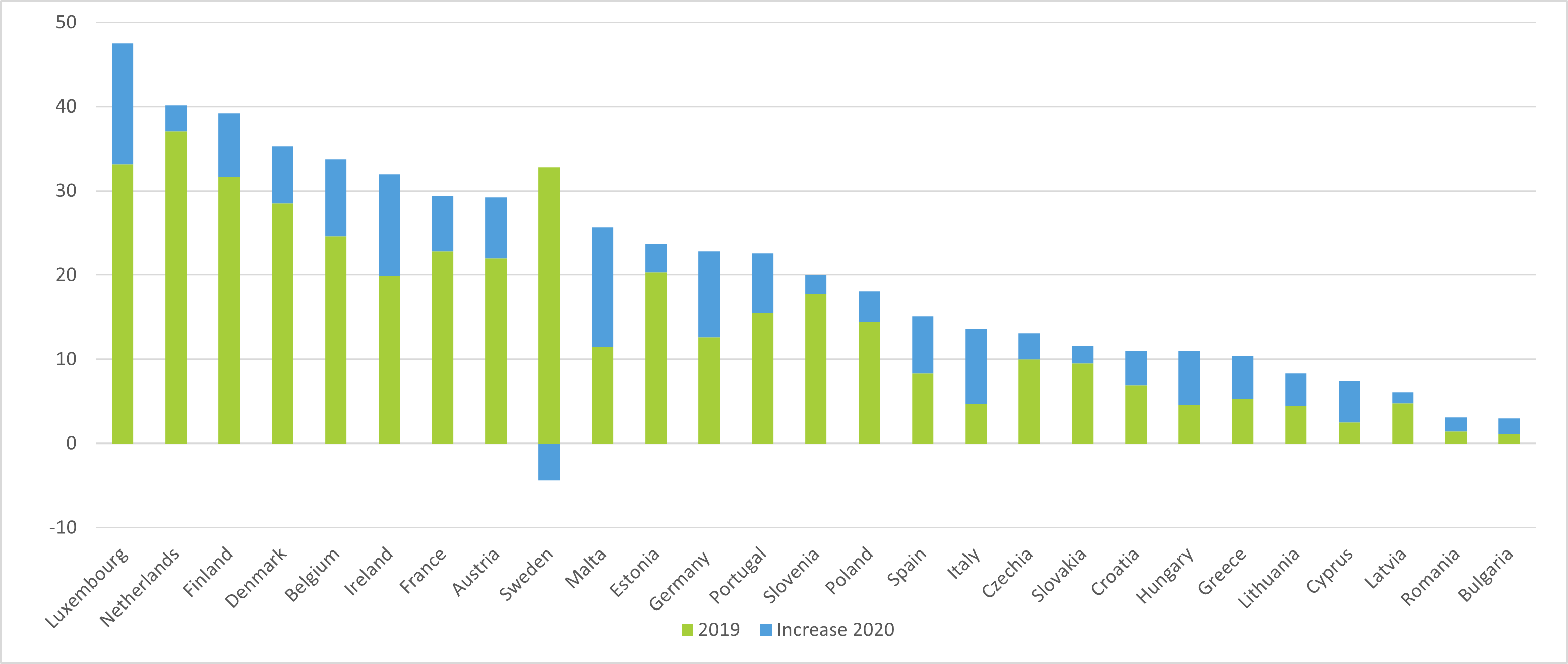
Source: EU-LFS 2019 and 2020
The EU-LFS distinguishes between workers who work ‘usually’ from home and those who do so ‘sometimes’. The surge in telework in 2020 was driven by an increase of people working usually from home. Prior to the pandemic, working sometimes from home was more common in most countries and in 2020 remained at similar levels as in 2019. In 2020, working usually from home became the more typical arrangement, with an increase, for instance, of more than 150% in Italy (Figure 2).
Figure 2: Percentage of workers working from home, either usually or sometimes, in the EU27, Germany, Spain, France and Italy, 2019 and 2020

Source: EU-LFS 2019 and 2020
What might the future hold?
One of the drivers of future developments in telework will be advances in digital technologies for work and the fact that more and more jobs will require the use of information and communication technologies (ICTs) and digital devices in general. This means, on the one hand, that the numbers of ‘teleworkable’ jobs are expected to grow and, on the other, that technology and job content will further facilitate remote working.
Another important indicator of what the future may hold are the preferences of workers and of companies. Two recent surveys conducted by Eurofound shed light on these preferences: the March 2021 round of the Living, working and COVID-19 e-survey, which explored workers’ preferences, and an online survey of company managers conducted in October 2020. Analysis of these data suggests that it is likely that telework will remain at a similar level as at present, or may decline a little, when all COVID-19-related restrictions are eased. The main difference from the pandemic period is that more workers will work remotely part of the time and work at their employer’s premises the rest of the time. This has become known as the ‘hybrid model’. In previous research, Eurofound labelled it occasional telework and found that it is not always formalised through an agreed arrangement or contract.
Considering the whole workforce, 60% of workers would like to work from home (daily or several times a week) after the pandemic. Focusing just on employees teleworking in February and March 2021, around half of them would prefer to work from home part of the time after the pandemic rather than do so exclusively. However, if workers’ preferences are an indication, exclusive telework will also continue to be significant: around one in three employees in the EU who worked only from home in February and March 2021 would continue to do so if they could decide their own work arrangement. These results are not surprising. Previous research by Eurofound has found that for individuals, telework offers opportunities to improve work–life balance and to have more autonomy in one’s job, as well as reducing commuting time.[3]
In general, companies that have implemented telework during the pandemic have a positive attitude towards this arrangement.[4] In fact, many have recently developed new telework policies, very often through agreements with workers’ representatives. By enabling telework, businesses potentially benefit from increases in productivity and the ability to attract highly qualified workers for whom telework is an important aspect of the job.
In July 2020, most employees (71%) reported that they were satisfied with working from home. Levels of satisfaction were notably high among those who were teleworking for 35 to 40 hours per week and those aged over 50 years old.
But not all workers share the enthusiasm for telework. Almost a quarter (23%) of respondents to the March 2021 e-survey indicated that they would not like to telework from home if not obliged to do so. The reason, in part, is the desire for human face-to-face interaction and the sense of well-being arising from that. Some of the working conditions experienced by remote workers and their negative impact on health and well-being is another explanatory factor. In the end, differences in preferences must be seen as normal and are related to individual circumstances and working conditions.
In the context of these results and bearing in mind that remote working will be a normal arrangement for many workers in Europe, Eurofound’s recent e-surveys provide insights into the working conditions and experiences of workers while teleworking during the pandemic. These need to be considered when designing and planning for remote working in the future.
Working conditions at home
Many of the risks associated with telework were known before the pandemic. Some of these relate to working time: long working hours, constant availability, blurring of boundaries between work and home life, and work–life balance challenges. Others relate to health and well-being, such as anxiety and eyestrain.
- Publication: Working anytime, anywhere: The effects on the world of work
- Publication: Telework and ICT-based mobile work: Flexible working in the digital age
- Working paper: Further exploring the working conditions of ICT-based mobile workers and home-based teleworkers
The Living, working and COVID-19 e-surveys confirm that some of these risks were also present in the obligatory or recommended telework setting during the pandemic. In this article, apart from the working time challenges, other issues that were not necessarily high on the policy agenda or in the public mind in pre-pandemic times are also highlighted. These include employers’ provision of work equipment, work–family conflicts arising from the additional burden of caring and home-schooling on parents, and feelings of isolation. For methodological reasons, the findings presented below focus on employees working full-time (35 and more weekly hours), so that the results are not affected by different working time arrangements or employment status. Other categories of employees are considered in some analyses, however, for comparison.
Working time disruptions
Autonomy and flexibility to organise one’s working time are inherent elements of telework. However, even though these can contribute to better job quality, they also have downsides, linked to the risk of working longer, irregular and non-standard hours and being under pressure to be available 24/7.
Longer working hours
Compared to employees working only at their employer’s premises, a higher share of workers working from home during the pandemic worked long hours of between 41 and 60 hours per week (Figure 3). This was the case for both ‘new’ teleworkers and those who had worked from home before the pandemic. Studies at national level across Europe – for example, in Greece,[5] Luxembourg[6] and Romania[7] – confirm these findings, reporting increased working hours among those who worked from home or increased prevalence of supplemental work (paid or unpaid work on top of the contractually agreed working hours) in the evening than those who remained at their employer’s premises.
Figure 3: Percentage of employees working between 41 and 60 hours a week, by place of work, EU27, March 2021
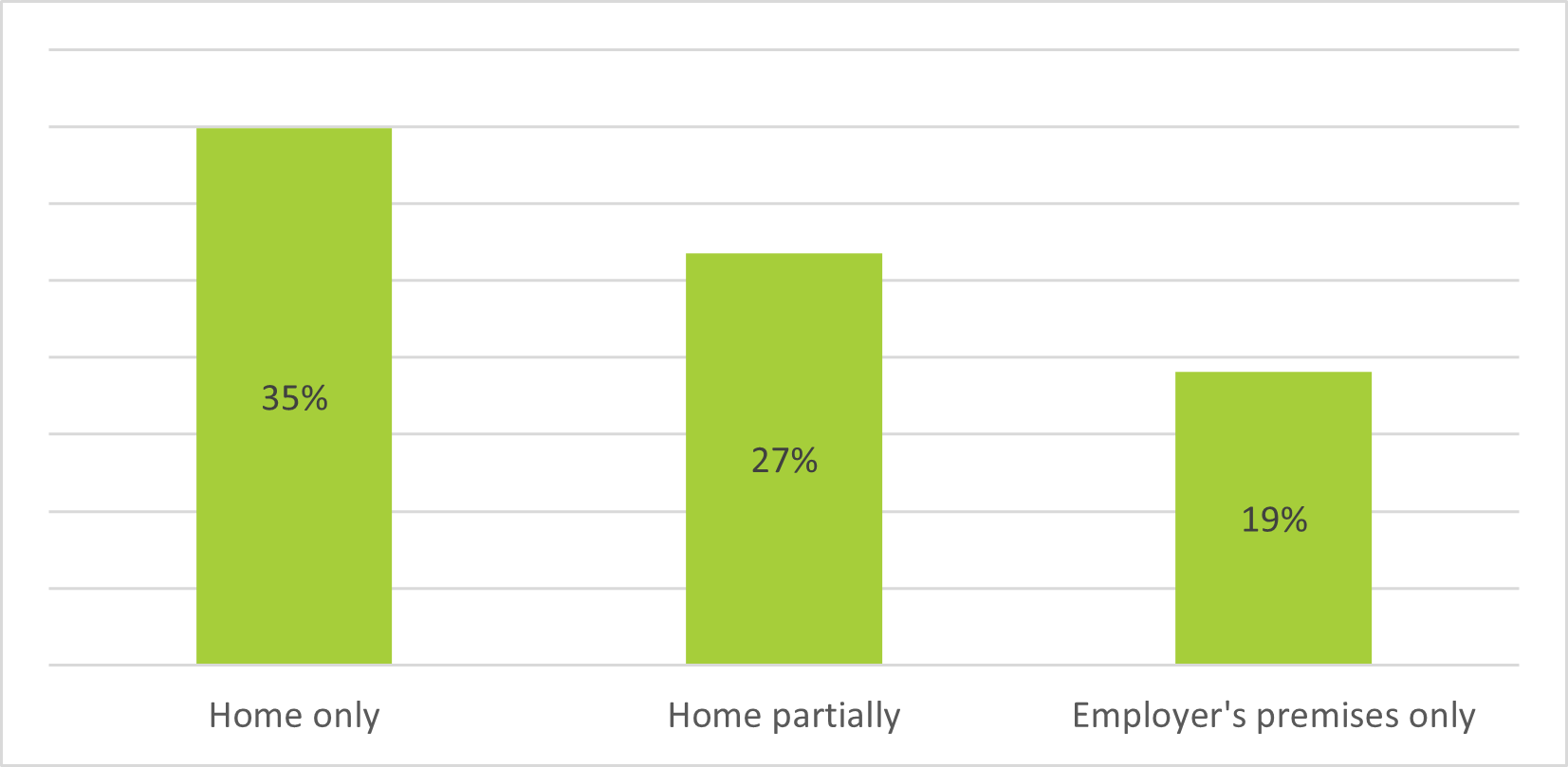
Source: Eurofound, Living, working and COVID-19 e-survey, round 3
Eurofound data indicate that there are two profiles of teleworkers who reported long working hours during the pandemic. One comprises employees working from home exclusively. The other is a group that works usually from their employer’s premises and extends their working time by doing supplemental work from home, for example by adding one or two hours to their day. In both cases, the ability to work remotely plays a role in working long hours.
Further analysis confirmed the association between the number of hours worked from home and total weekly working hours, finding a positive and relatively strong correlation between the two variables (r = 0.58).[8] In addition, a linear regression analysis produced a statistically significant result suggesting that the more hours worked from home, the more hours the employee will work in total during the week.
A breeding ground for working in free time
Studies over several years have shown that, independently of the socioeconomic context, employees who telework are more likely to work in their free time than those who work only at an employer’s premises.
Before the pandemic, Eurofound research found that having no boundary between the work and home environments and having the tools for work constantly on hand contribute to working longer hours and in one’s free time, even if, or partly because, employees enjoy high levels of autonomy. This is particularly true when coupled with a heavy workload.[9]
However, the experience of the pandemic shows that other demands, not exclusively connected to work organisation, caused people to work in their leisure time. One such demand was that experienced by parents who had to home-school children when schools were closed while continuing to meet work deadlines and targets. For example, in Portugal and Ireland, during the school closures of February and March 2021, around 40% of teleworking employees with children reported working in their free time. This figure was significantly higher than the percentages for the rest of the Member States and the EU average at that time (27%).[10] Employees with children who experienced school closures were more likely to report working in their free time.
Caring for children in general is a factor related to working in free time. In March 2021, 29% of those with children aged between 0 and 11 and who were working from home reported working in their free time ‘every day or every other day during the last month’, compared to 20% of those without children (Figure 4).
Figure 4: Percentage of full-time employees who worked in their free time, by place of work and parental status, EU27, March 2021
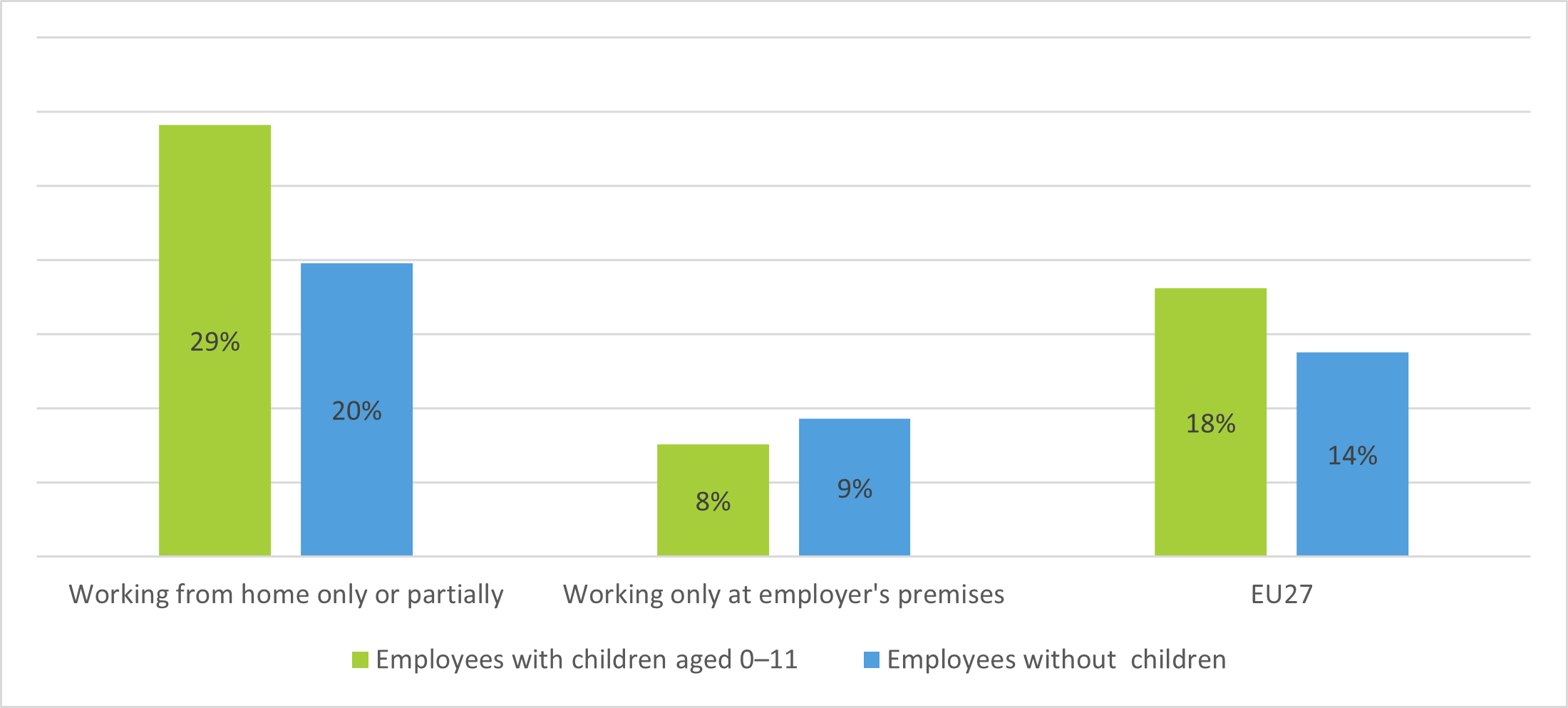
Source: Eurofound, Living, working and COVID-19 e-survey, round 3
Gender differences are also apparent here. Among those working only from home (with a part-time or full-time job), a higher proportion of women (25%) than men (19%) worked in their free time. The difference is even larger when looking at employees with children (aged 0–11) working only from home (35% of women vs. 23% of men).
In summary, during the pandemic, for some employees with a caring role, working in their free time meant a change in the scheduling of different activities (home schooling, etc.) and not necessarily that they were doing supplemental work. It represented a change in the organisation of working time rather than in its duration, a consequence of the work–family interface. It is estimated that one in three employees who worked in their free time followed this pattern and that more women than men were in this situation. However, the analysis also shows that for most employees working in free time meant an increase in the duration of working time and working long hours.
What do we know about the employees who worked in their free time?
Parents who teleworked during the pandemic were more likely to work in their free time, but are there any occupational or employment-related characteristics of employees who did so? While the e-survey did not ask respondents about their occupation, it did ask about their education and the sector where they work, and these data can be used to answer this question (because, as the EU-LFS 2020 shows, there is an association between occupational skill level and level of education).
The findings show that, among employees who worked from home, those who did so in their free time include both employees with high level of education (27% of those with higher education) and those with education to secondary and primary levels (16% of employees with these levels of education). These findings suggest that not only professionals and managers (who tend to have higher educational attainment) worked in their free time, but also workers in occupations requiring lower skill levels. This is certainly a consequence of the massive take-up of remote working. The sector in which working in free time was most common is education, where there was a difference of 36 percentage points between those who worked from home and those who did not. It was also more likely in public administration, other services, health and financial services.
An additional occupational characteristic associated with working in one’s free time seems to be the type of contract one has. Whereas the share of those working in their free time but not from home does not differ between workers with permanent and temporary contracts, the gap widens to 10 percentage points among teleworkers (20% of those with a permanent contract versus 30% of those with a temporary contract).
Work–life balance versus work–family conflict
An objective perspective might suggest that telework and working in one’s free time can be combined as a strategy to achieve a good fit between work and family (and school) demands. However, a subjective perspective on work–family conflict might interpret the results differently. In general, among full-time workers working remotely, those who worked long hours (more than 40 hours a week) were more likely to report work–family conflicts such as being unable to concentrate on their work because of their family responsibilities.
Furthermore, among the group who worked more than 40 hour per week, more women reported such problems than men. Whereas among those who worked 35 to 40 hours per week, the result is the opposite: a higher share of men experienced an inability to concentrate (Figure 5). Work–life conflicts have implications for people’s attitude to telework, as satisfaction with telework decreases among those who find it difficult to concentrate on their job because of family responsibilities.
Figure 5: Percentage of full-time employees who reported an inability to concentrate on their job because of family responsibilities, by hours worked from home, EU27, March 2021
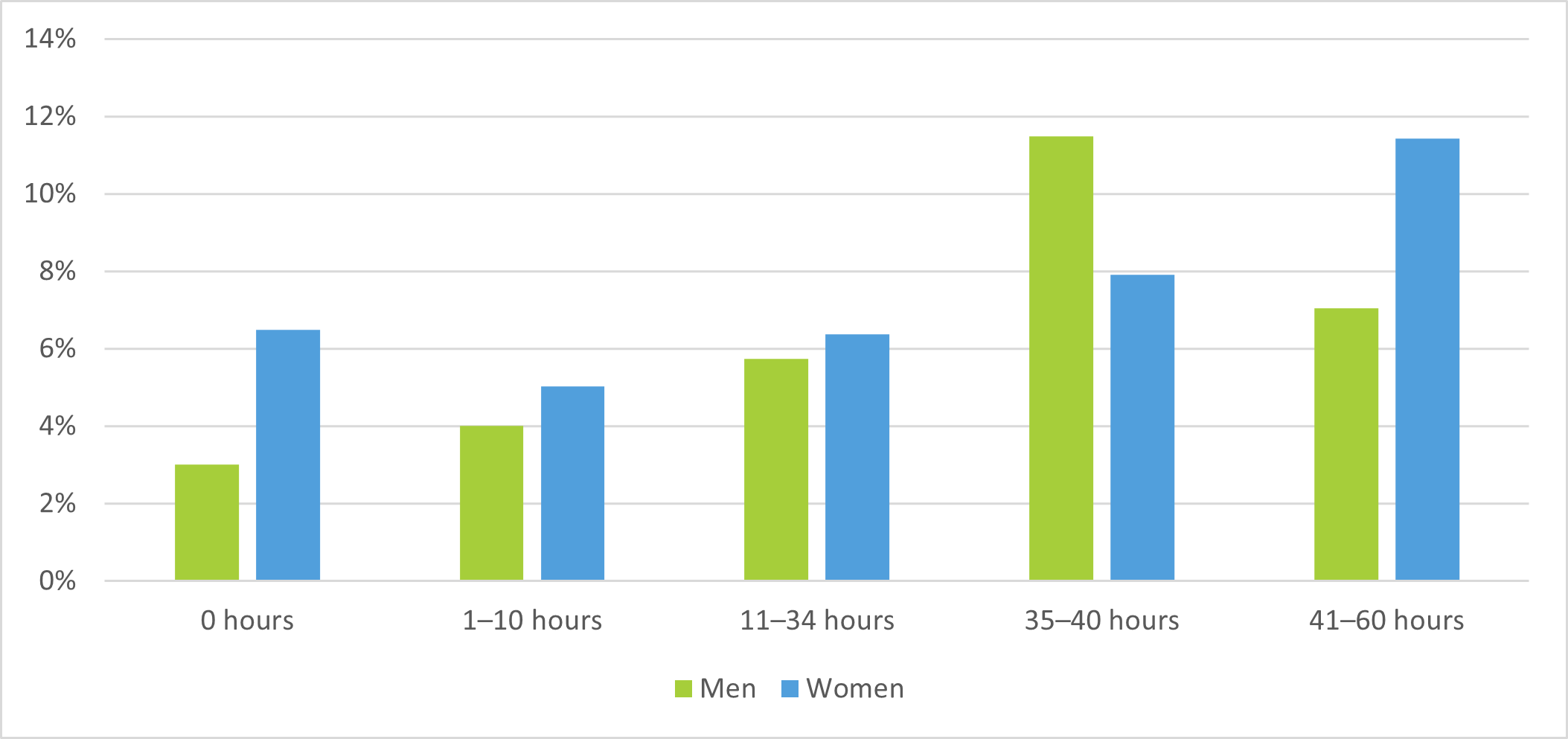
Source: Eurofound, Living, working and COVID-19 e-survey, round 3
These findings suggest that despite the potential of telework to improve work–life balance, conflict between the demands of work and domestic life remains an issue in this arrangement for some employees. However, this could be something that will ease after the pandemic.
Psychological consequences
Some respondents to the July 2020 e-survey round who were working from home and reported working long hours also reported some worrying well-being outcomes, such as feeling emotionally drained or feeling isolated. The data show that the probability of experiencing these feelings increased with the number of hours worked from home (Figure 6). Among employees who worked 41–60 hours from home, 20% felt isolated and 39% felt emotionally drained by work always or most of the time. This compares to 14% and 34%, respectively, among those who worked the same range of hours at an employer’s premises. The issue of isolation and disrupted communication with colleagues has been reported also by national studies in Denmark[11] and Finland.[12]
Figure 6: Percentage of full-time employees feeling isolated at work, by hours worked from home, EU27, July 2020
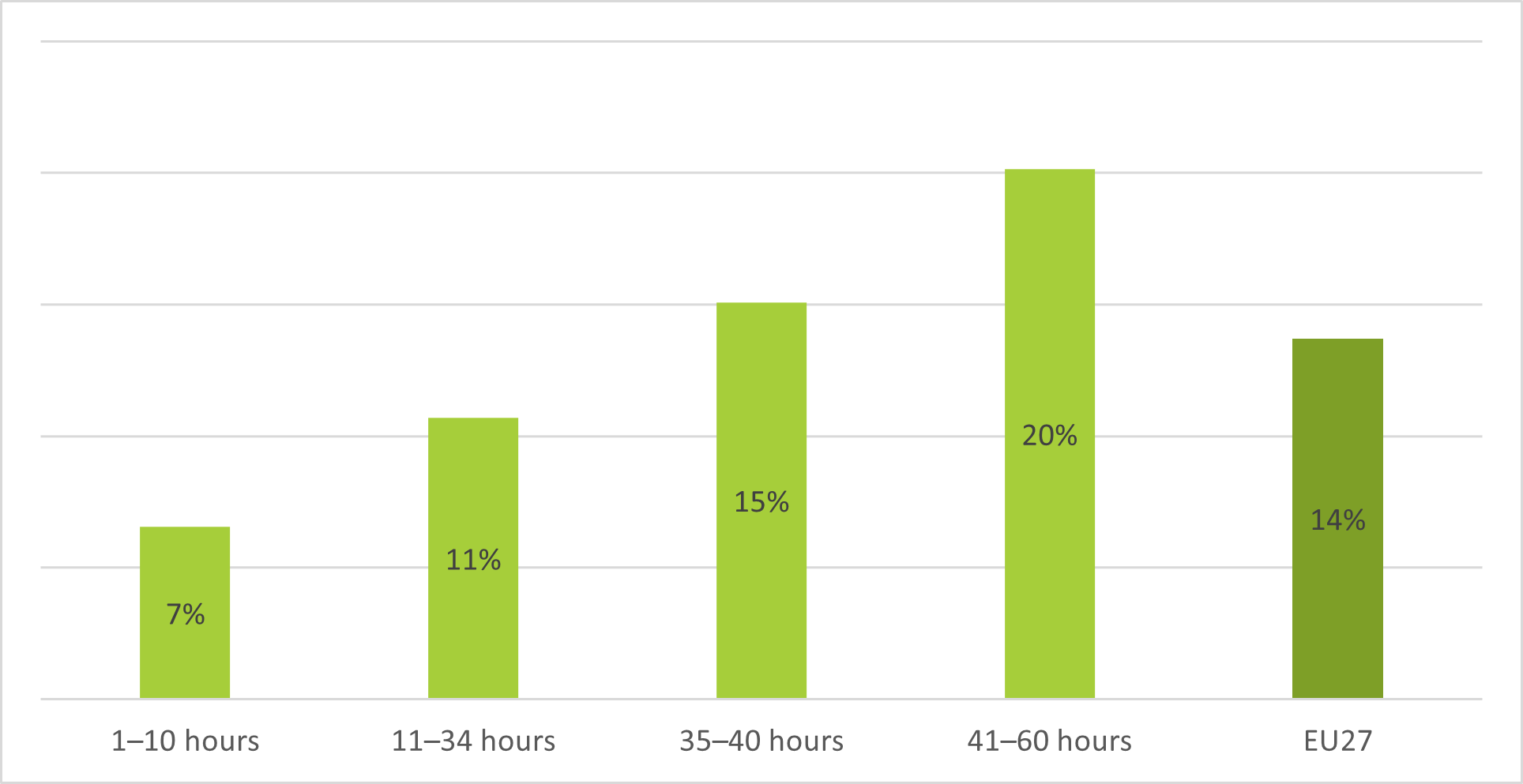
Source: Eurofound, Living, working and COVID-19 e-survey, round 2
In addition, some indicators related to psychological well-being are worse for this group of home workers; these include feeling cheerful, feeling calm, and waking up fresh and active. However, an improvement in these indicators is apparent between the July 2020 and March 2021 rounds, which could be interpreted as increasing adaptation to the remote working environment, at least from the psychosocial point of view.
Inadequate provision of equipment
The sudden expansion of telework has raised issues related to the physical conditions for working at home, one of which is the provision of equipment by the employer.
Findings from July 2020 show that workers who were working part time from home were more likely to report that their equipment (computer, desk, chair and so on) was inadequate for their needs. For example, 16% of those working remotely for 1–10 hours a week reported this situation compared to 9% people working remotely full time (35–40 hours). Further analysis demonstrated that having the right equipment may play a decisive role in determining employees’ satisfaction with telework. Among employees with good equipment, 77% were satisfied with telework compared to 31% of those without the appropriate equipment.
More striking are the results in relation to the provision of work equipment by the employer: around one in three employees in the EU working remotely reported that their employer did not provide the equipment for working from home. Moreover, half of those working from home for 1–10 hours reported not having received equipment from their employer. This represents a disadvantage for workers who must use their own equipment when carrying out work-related tasks.
Overall, people working occasionally from home have been more affected by shortfalls related to equipment or its provision.
Interestingly, problems with equipment are reported to different extents depending on the sector in which the employee works. For instance, proportionately more employees in the education sector than any other sector were not provided with equipment by their employer (Figure 6).
Figure 7: Percentage of full-time employees reporting inadequacy or lack of employer provision of equipment for telework, by sector, EU27, July 2020
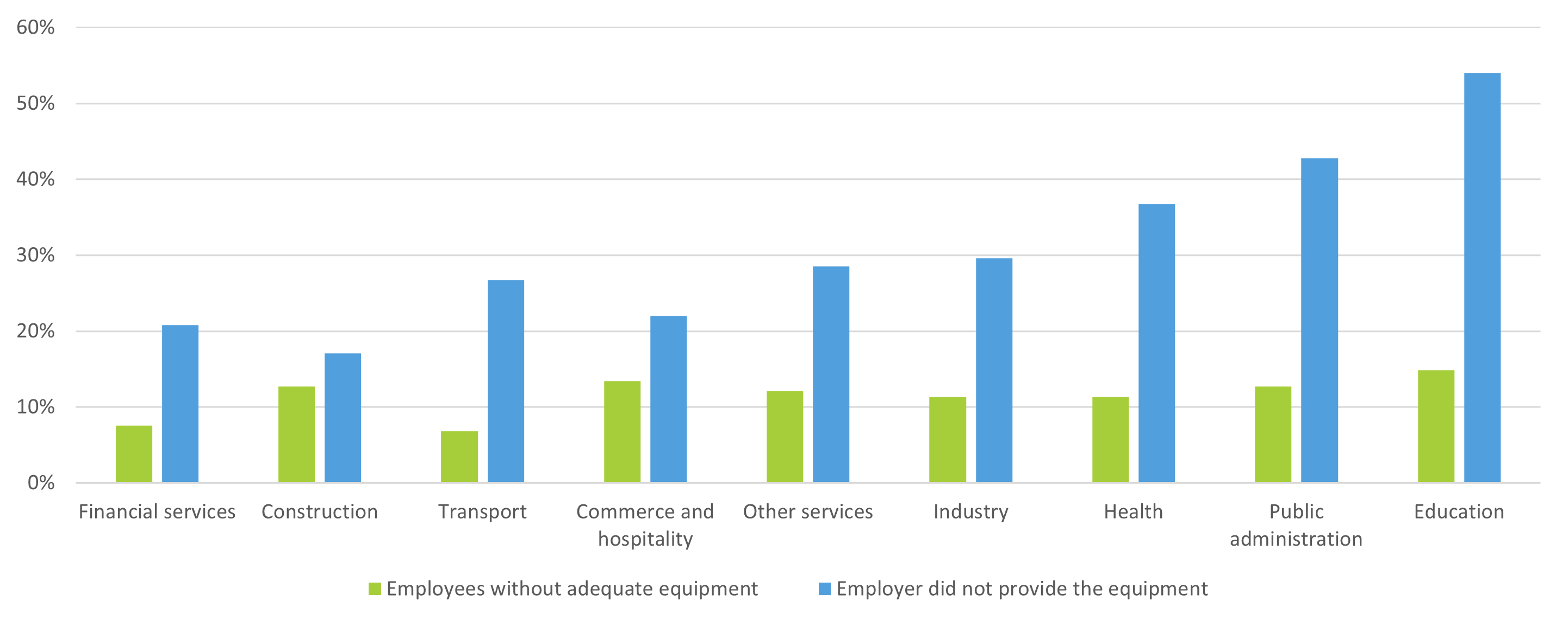
Source: Eurofound, Living, working and COVID-19 e-survey, round 2
These challenges related to the psychosocial and physical environment pose short- and long-term risks for the health of the European employees.
Concluding remarks
The article has identified a number of challenges posed by telework during the pandemic. Some are specific to this period, while others arise from the nature of remote working. Improving conditions in this work arrangement could have a significant impact on the satisfaction of employees with telework and their wish to do it. Europe is at a pivotal moment, making a transition towards more flexible ways of organising work. In this change, it is important that there is proper regulation addressing the challenges, such as provision of adequate equipment, organisation of working time and isolation. It is equally important that the positive aspects of working remotely are fostered, including work–life balance, job autonomy and flexible time use. Social dialogue between employees and employers at all levels will be essential so that solutions respond to the needs of both sides of industry. The following conclusions could be relevant for these purposes.
The organisation of working time should be addressed and regulated in a way that discourages workers from working in their free time and working long hours, placing a specific focus on the risks posed by working remotely. It is a key condition for improving other issues in telework arrangements. The ‘sweet spot’ in this regard could be hybrid telework or full-time telework (35–40 hours), as long as it is not supplemental to contractual working time. Initiatives related to the right to disconnect, recording working time and real (and not cosmetic) company cultural changes led by managers can contribute.
During the pandemic, the lockdowns revealed the huge potential that telework has for enabling workers to manage work with other demands and achieve better work–life balance. However, an undesirable side-effect was that some workers found themselves trying to take care of domestic and work demands at the same time. In this regard, the interaction between work and caring roles must be monitored to avoid undesired consequences for parents and for gender equality. A lesson learnt for the future is that to avoid these problems, there is a need for effective work–life balance policy and to educate employers and employees in the use of the working time autonomy. This would constitute a real cultural change in the world of work.
There is a need to address the psychosocial challenges associated with teleworking, such as isolation. The pandemic also revealed issues around equipment; policymakers should ensure that the right equipment is provided to employees working remotely, regardless of the amount of time they spend at it. Appropriate equipment is particularly important when the workplace is outside the employer’s premises, given the challenges for the implementation of occupational safety and health regulations. Some economic sectors are more affected by this issue than others.
Some groups of workers can benefit especially from working remotely, and individual and family circumstances play a role. For example, it is a positive sign that employees over 50 years old have shown a very high level of satisfaction with working remotely. This response is in part related to their need for flexible working time, and it suggests that telework could contribute to enabling people to work longer. It is also related to the health benefit, suggesting that telework can make work more sustainable for some workers in this age group.
Telework will be a key feature of the work organisation in the future world of work, and a substantial number of workers across Europe will engage in it, either part time or full time, although with substantial differences by country. It is important that policies ensure that all workers, regardless of the number of hours they telework or their country of residence, benefit from initiatives for improving working conditions. For this, minimum standards should be set at EU, national and sectoral levels to avoid poor working conditions. But, as one size might not fit all, there should be some room to manoeuvre at company and lower levels so that both employees and employers can get the most from this mode of working.
Image © Roman Tyukin/Adobe Stock Photos
Notes
- ^ The article is based mainly on the analysis of data from round 2 (fieldwork carried out in June and July 2020) and round 3 (fieldwork carried out in February and March 2021) of the e-survey and refers to these as the July 2020 round and the March 2021 round. Where possible, the most recent data collection (March 2021) is used.
- ^ The two EU-LFS figures show yearly averages. Because data is collected at different points during the year, EU-LFS data represent a more realistic picture of telework trends. However, the results of this survey may vary from other EU or national-level surveys, where estimates are based on data collected during a specific week or month, for example.
- ^ Eurofound and the International Labour Office (2017), Working anytime, anywhere: The effects on the world of work, Publications Office of the European Union, Luxembourg, and the International Labour Office, Geneva; Eurofound (2020a), Telework and ICT-based mobile work: Flexible working in the digital age, New forms of employment series, Publications Office of the European Union, Luxembourg; Eurofound (2020b), COVID-19 unleashed the potential for telework – How are workers coping? blog post, 9 June.
- ^ Eurofound (forthcoming), COVID-19 and the impact on business continuity: Changes in workplace practices, Publications Office of the European Union, Luxembourg.
- ^ GSEE (2021), Labour market climate indicators: Large decrease in income for private sector employees, press release, 19 January.
- ^ Portail des statistiques du Grand-Duché de Luxembourg (2020), Le télétravail, à consommer avec modération? Luxembourg.
- ^ Wisemetry (2020), Studiu Wisemetry Research: 37% dintre cei care au muncit în regim mixt – de la birou și de acasă – spun că lucrează mai mult, ca timp alocat, în regim telemuncă, Pitești, Romania.
- ^ Pearson’s correlation coefficient for hours working from home and total weekly working hours; significant at 5%.
- ^ Eurofound (2020a), see note 3.
- ^ During February and March 2021, there were also some countries with some type of partial school closures (or hybrid schooling). Therefore, it is very likely that the differential impact of school closures on working in one’s free time was much higher than the one showed in this analysis.
- ^ Finansforbundet (2020), Kan Vi Lære as Arbejde Smartere af Nedlukningen? 28 May.
- ^ Blomqvist, K., Sivunen, A., Vartiainen, M., Olsson, T., Ropponen, A., Henttonen, K. et al (2020), Etätyö Suomessa koronaviruspandemian aikana – pitkittäistutkimuksen tuloksia, Futuremote.